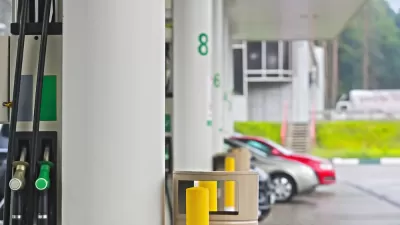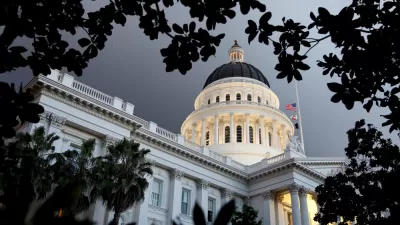Carl Davis, Research Director of the Institute on Tax and Economic Policy (ITEP) writes where gas taxes used to fund transportation infrastructure increased, if only by decimal points, and about the aberration—the six-cent plunge in California.
"The largest gas tax increases are taking place in Idaho (7 cents per gallon) and Georgia (6.7 cents for gas and 7.7 cents for diesel)," writes Davis. "Each of these increases is occurring due to legislation enacted earlier this year."

- Maryland's gas tax increase stem from 2013 legislation signed by then-Governor Martin O'Malley (now a presidential candidate).
- "Rhode Island’s 1 cent increase is the first automatic update for inflation to take place under a law signed by former Gov. Lincoln Chafee in 2014 (Chafee is now a presidential candidate as well)," writes Davis.
- Finally, Nebraska’s 0.5 cent hike and Vermont’s 0.35 cent increase are automatic changes resulting from these states’ variable-rate gas tax structures. Surprisingly, 19 states and the District of Columbia have this type of gas tax structure according to a February ITEP report.
On to the negative side of fuel tax changes that took effect July 1:
- California's six-cent tax decrease from 36 cents to 30 cents results from a vote of the state's Board of Equalization on Feb. 24 required by the 2010 gas tax swap legislation. Legislation has been introduced to change the formula to avoid the large spikes in increases or decreases required.to adjust the tax. SB 321 passed the Senate 40-0 on June 1 and is now in the Assembly. But it's not all negative as Davis notes that "a unique quirk in California’s law will cause the diesel tax to rise by 2 cents."
- Connecticut: "The diesel tax rate will drop by 4.2 cents as a result of laws linking gas tax rates to gas prices," writes Davis. "Earlier this year, similar automatic cuts had been scheduled to take place in Kentucky and North Carolina, but lawmakers in both of these states wisely intervened by placing a 'floor' on their gas tax rates that minimized the loss of infrastructure revenue," adds Davis.
Perhaps it's not correct to list those two states as gas tax increases as they in fact decreased - but they are included among the "seven states" in an earlier Planetizen post of 2015 state legislated gas tax increases nonetheless.
Additional notes on state gas taxes mentioned above:
- Don't confuse Nebraska's mandated half-cent gas tax increase with an upcoming gas tax increase of 1.5 cents on Jan. 1, 2016 that results from LB 610's passage on May 14 when the Senate overrode Gov. Pete Ricketts veto. It will be the first phase of a six-cent gas tax increase.
- In addition to SB 321 to adjust the formula used to make future gas tax changes to be voted on by the California Board of Equalization, Sen. Jim Beall has an additional bill to increase the excise tax by 10-cents, SB 16. Look for the bill under a new number, SB 1X, as it will be the topic of a special session on transportation called by Gov. Jerry Brown.
Finally, omitted above is:
- Alaska's .95 cent gas tax increase: It is not included as this post is based on the ITEP news blog. In an email, ITEP research director Carl Davis explained that only infrastructure-funding tax changes were included. The Alaska tax increase, as significant (or insignificant) it may be, will be used to fund oil spill prevention and response.
FULL STORY: Gas Tax Changes Take Effect July 1

Alabama: Trump Terminates Settlements for Black Communities Harmed By Raw Sewage
Trump deemed the landmark civil rights agreement “illegal DEI and environmental justice policy.”

Study: Maui’s Plan to Convert Vacation Rentals to Long-Term Housing Could Cause Nearly $1 Billion Economic Loss
The plan would reduce visitor accommodation by 25% resulting in 1,900 jobs lost.

Why Should We Subsidize Public Transportation?
Many public transit agencies face financial stress due to rising costs, declining fare revenue, and declining subsidies. Transit advocates must provide a strong business case for increasing public transit funding.

Paris Bike Boom Leads to Steep Drop in Air Pollution
The French city’s air quality has improved dramatically in the past 20 years, coinciding with a growth in cycling.

Why Housing Costs More to Build in California Than in Texas
Hard costs like labor and materials combined with ‘soft’ costs such as permitting make building in the San Francisco Bay Area almost three times as costly as in Texas cities.

San Diego County Sees a Rise in Urban Coyotes
San Diego County experiences a rise in urban coyotes, as sightings become prevalent throughout its urban neighbourhoods and surrounding areas.
Urban Design for Planners 1: Software Tools
This six-course series explores essential urban design concepts using open source software and equips planners with the tools they need to participate fully in the urban design process.
Planning for Universal Design
Learn the tools for implementing Universal Design in planning regulations.
Smith Gee Studio
Alamo Area Metropolitan Planning Organization
City of Santa Clarita
Institute for Housing and Urban Development Studies (IHS)
City of Grandview
Harvard GSD Executive Education
Toledo-Lucas County Plan Commissions
Salt Lake City
NYU Wagner Graduate School of Public Service




























